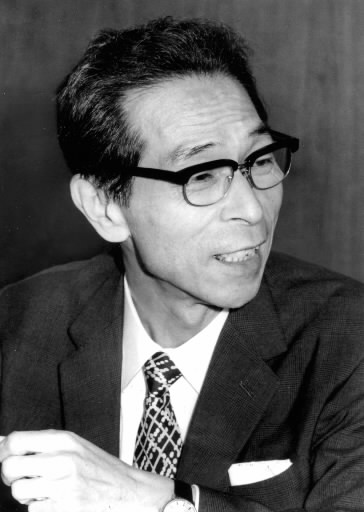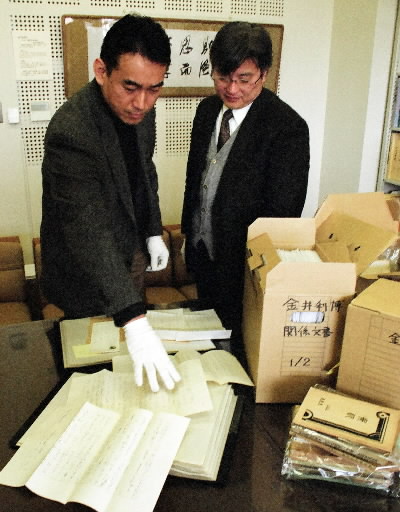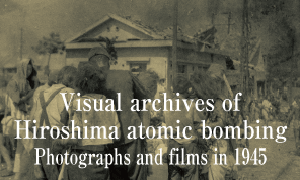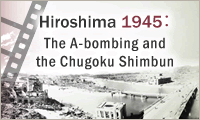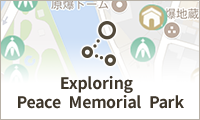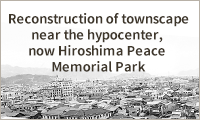Relative of the late Toshihiro Kanai donates 8,000 documents to Hiroshima University
Mar. 10, 2010
by Masami Nishimoto, Senior Staff Writer
A relative of the late Toshihiro Kanai (1914-1974), a journalist who built the foundation of news reporting of A-bomb-related issues in Hiroshima, has donated some 8,000 documents left behind by the journalist to the Hiroshima University Archives. These documents include valuable letters from the author Kenzaburo Oe, the poet Shinoe Shoda, and other writers whose works are connected to Hiroshima. The Archives plans to make the list of materials public on its website, and comprehensive studies will be conducted on the documents along with other existing documents related to campaigns against atomic and hydrogen bombs.
"Have the atomic bombs come to be known for their power, or for their human tragedy?" questioned Mr. Kanai. When Mr. Kanai was an editorial writer for the Chugoku Shimbun back in 1964, he proposed compiling a white paper on the consequences of the atomic bombing at a Hiroshima conference involving A-bomb and H-bomb sufferers from three prefectures. His perspective of viewing nuclear weapons not from the standpoint of national interest but from human suffering influenced a variety of movements, including the preservation of the Atomic Bomb Dome, the hypocenter reconstruction campaign, and other efforts by citizens, universities, governments, and the media.
Most of the documents are materials Mr. Kanai referred to while writing the book Kaku kenryoku, Hiroshima no kokuhatsu ("Nuclear Might: Accusations from Hiroshima") just before his death, and records and letters written in the process of cultural recovery efforts around the time of the establishment of the Hiroshima Pen Club (established in 1949), for which Mr. Kanai exerted himself.
In the letters from Mr. Oe, the Nobel Prize-winning author expressed his thoughts about his 1965 book Hiroshima noto ("Hiroshima Notes"), in which he wrote about how he met Mr. Kanai, his support for the campaign for the white paper, and a eulogy.
Also included in the documents are letters indicating Mr. Kanai's friendly relationships with Toshiyuki Kajiyama, who made great efforts in erecting a monument inscribed with a poem by Tamiki Hara, which now stands in Hiroshima Peace Memorial Park; the poet Ms. Shoda, author of Sange, a collection of tanka poems; the folklorist Tsuneichi Miyamoto, who studied lives in the mountainous areas and at the seaside; and the writer Tomoe Yamashiro.
Yumiko Yamamoto, 61, the eldest daughter of Mr. Kanai, sorted through the documents at his former residence in Higashi Ward, Hiroshima, and decided to donate them to the Hiroshima University Archives, which holds a collection of academic publications on peace studies.
Professor Seiichi Koike, director of the Archives, commented, "By tracing the path Mr. Kanai took, we can understand the history of how Hiroshima's appeals were formed. I would like to study the documents and contribute to the further deepening of peace studies in Hiroshima."
(Originally published on March 8, 2010)
A relative of the late Toshihiro Kanai (1914-1974), a journalist who built the foundation of news reporting of A-bomb-related issues in Hiroshima, has donated some 8,000 documents left behind by the journalist to the Hiroshima University Archives. These documents include valuable letters from the author Kenzaburo Oe, the poet Shinoe Shoda, and other writers whose works are connected to Hiroshima. The Archives plans to make the list of materials public on its website, and comprehensive studies will be conducted on the documents along with other existing documents related to campaigns against atomic and hydrogen bombs.
"Have the atomic bombs come to be known for their power, or for their human tragedy?" questioned Mr. Kanai. When Mr. Kanai was an editorial writer for the Chugoku Shimbun back in 1964, he proposed compiling a white paper on the consequences of the atomic bombing at a Hiroshima conference involving A-bomb and H-bomb sufferers from three prefectures. His perspective of viewing nuclear weapons not from the standpoint of national interest but from human suffering influenced a variety of movements, including the preservation of the Atomic Bomb Dome, the hypocenter reconstruction campaign, and other efforts by citizens, universities, governments, and the media.
Most of the documents are materials Mr. Kanai referred to while writing the book Kaku kenryoku, Hiroshima no kokuhatsu ("Nuclear Might: Accusations from Hiroshima") just before his death, and records and letters written in the process of cultural recovery efforts around the time of the establishment of the Hiroshima Pen Club (established in 1949), for which Mr. Kanai exerted himself.
In the letters from Mr. Oe, the Nobel Prize-winning author expressed his thoughts about his 1965 book Hiroshima noto ("Hiroshima Notes"), in which he wrote about how he met Mr. Kanai, his support for the campaign for the white paper, and a eulogy.
Also included in the documents are letters indicating Mr. Kanai's friendly relationships with Toshiyuki Kajiyama, who made great efforts in erecting a monument inscribed with a poem by Tamiki Hara, which now stands in Hiroshima Peace Memorial Park; the poet Ms. Shoda, author of Sange, a collection of tanka poems; the folklorist Tsuneichi Miyamoto, who studied lives in the mountainous areas and at the seaside; and the writer Tomoe Yamashiro.
Yumiko Yamamoto, 61, the eldest daughter of Mr. Kanai, sorted through the documents at his former residence in Higashi Ward, Hiroshima, and decided to donate them to the Hiroshima University Archives, which holds a collection of academic publications on peace studies.
Professor Seiichi Koike, director of the Archives, commented, "By tracing the path Mr. Kanai took, we can understand the history of how Hiroshima's appeals were formed. I would like to study the documents and contribute to the further deepening of peace studies in Hiroshima."
(Originally published on March 8, 2010)

